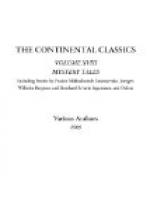The bridal couple, as well as the wedding guests, were in the gayest mood, and the ball was an undoubted success. The dancing was interrupted for an hour while supper was served in an adjoining room. After the repast the guests returned to the hall, and it was several hours more before the last dance was called. The season was early autumn and the weather still balmy. The windows had been opened to freshen the air. But the walls retained their dampness and suddenly the dancers noticed that the old wall paper which covered the partition wall between the hall and the sealed chamber had been loosened through the jarring of the building, and had fallen away from the sealed door with its mysterious inscription.
The story of the sealed chamber had been almost forgotten by most of those present, forgotten with many other old legends heard in childhood. The inscription thus suddenly revealed naturally aroused great interest, and there was a general curiosity to know what the mysterious closed room might hide. Conjectures flew from mouth to mouth. Some insisted that the closed door must hide the traces of a hideous murder, or some other equally terrible crime. Others suggested that perhaps the room had been used as a hiding place for garments and other articles belonging to some person who had died of a pestilence, and that the room had been sealed for fear of spreading the disease. Still others thought that in the sealed chamber there might be found a secret entrance from the cellars, which had made the room available as a hiding place for robbers or smugglers. The guests had quite forgotten their dancing in the interest awakened by the sight of the mysterious door.
“For mercy’s sake, don’t let’s go too near it!” exclaimed some of the young ladies. But the majority thought it would be great fun to see what was hidden there. Most of the men said that they considered it foolish not to have opened the door long ago, and examined the room. The young bridegroom did not join in this opinion, however. He upheld the decision of his mother-in-law not to allow any attempt to effect an entrance into the room. He knew that there was a clause in the title deeds to the house which made the express stipulation that no owner should ever permit the corner room to be opened. There was discussion among the guests as to whether such a clause in a title deed could be binding for several hundred years, and many doubted its validity at any time. But most of them understood why Madame Wolff did not wish any investigation, even should any of those present have sufficient courage to dare the curse and break open the door.




